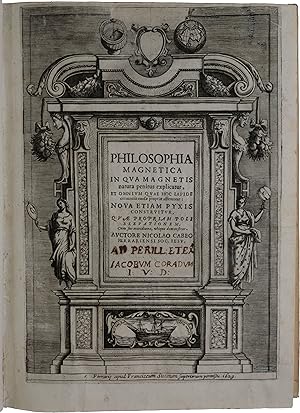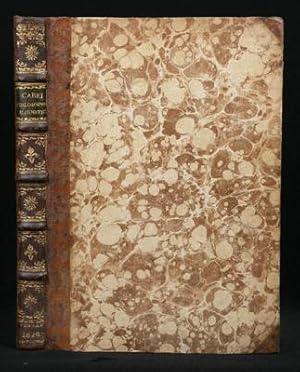Philosophia Magnetica (4 Ergebnisse)
Produktart
- Alle Produktarten
- Bücher (4)
- Magazine & Zeitschriften
- Comics
- Noten
- Kunst, Grafik & Poster
- Fotografien
- Karten
-
Manuskripte &
Papierantiquitäten
Zustand
Einband
- alle Einbände
- Hardcover (3)
- Softcover
Weitere Eigenschaften
- Erstausgabe (2)
- Signiert
- Schutzumschlag
- Angebotsfoto
- Kein Print-on-Demand (2)
Gratisversand
Land des Verkäufers
Verkäuferbewertung
-
First edition. UNIQUE PRE-PUBLICATION PRESENTATION COPY. First edition, a unique pre-publication presentation copy by Cabeo to his teacher Jacobo Corrado, of the first extensive study of magnetism since William Gilbert's De Magnete (1600). Corrado's name is handwritten on the title page, which is in an unfinished state, the coat-of-arms at the head having been left un-engraved; in addition, there is an eleven-line manuscript dedication on the second leaf, which is blank but usually contains the Privilege of the Emperor Charles V. In the dedication Cabeo thanks his teacher and praises him for his vast knowledge. "His first book, the Philosophia magnetica, discussed not only Gilbert's but also Cabeo's own experimental investigations of terrestrial magnetism as well as magnetized iron and 'lodestone' (the mineral magnetite). The central focus of his work, like Gilbert's before him, was therefore the study of the magnetic behaviors of compass needles. Where Gilbert, however, argued that the Earth itself is a giant magnet, whose poles reproduce the poles of an ordinary magnet and with which it interacts, Cabeo maintained instead that magnetic properties are inherent to certain sorts of matter; they did not subsist in their relationships to the great magnet, the Earth. Indeed, Cabeo denied that the Earth itself is a great magnet, even though it contains matter lending it magnetic effects. He also, again following Gilbert, discussed magnetic attraction between rubbed objects (typically, pieces of amber resin) and light objects such as bits of straw or paper; the attractive virtues of such electrified bodies appeared to be sufficiently similar to those of magnets that it seemed appropriate to investigate them together. In accounting for the production of electrical attraction by certain kinds of matter when they are rubbed, Cabeo-always, as a natural philosopher, on the lookout for causal explanations of phenomena, not simply their descriptions-suggested that the rubbing stimulates the emission of tiny particles, as an effluvium, from the rubbed body's pores, which, in its interaction with the surrounding air, tends to move light objects toward it as a result of the rarified air's subsequent behavior. In the Philosophia magnetica, Cabeo considered the methodological and epistemological issues relating to his experimental investigations. He stressed that his work sought the causes behind natural effects (this being the usual goal of Aristotelian-style natural philosophy) but that he would proceed by borrowing the approach of the mathematicians because it was so clear and demonstrative. He also stressed the extent to which his discussions were based upon experimental work, his experiments having been repeated numerous times, with multiple witnesses on hand to guarantee the truth of his reports. The necessity of saying such things stemmed from the unusual nature of the phenomena Cabeo described; neither magnetic nor electrical effects were generally familiar from everyday experience, and arguments based on unusual and contrived experimental behaviors therefore needed special justification to be accepted" (DSB). No presentation copy on ABPC/RBH. Cabeo (1586-1650) entered the Jesuit order as a novice in 1602. "Cabeo's academic training occurred primarily at Parma, following the usual Jesuit curriculum of the period, and included the study of logic, natural philosophy (centered on the works of Aristotle), metaphysics, and theology; he clearly also studied some mathematics. Following the completion of his studies around 1616, Cabeo taught theology, philosophy, and metaphysics at Parma until 1621; he subsequently spent several years living at the Jesuit college back in Ferrara, his birthplace, and taught some theology there in the late 1620s. At the end of his life he returned to teaching, now at the Jesuit college in Genoa. In the meanwhile, he served the ducal courts in Mantua and in Modena, made use of his mathematical expertise in work on civil engineering projects, and was an itinerant preacher. He remained throughout his life engaged in issues of mathematics and natural philosophy, debating issues of mechanics, free fall, and motion with such contemporaries and familiars as Giovanni Battista Baliani, Benedetto Castelli, and Giovanni Battista Riccioli, as well as publishing his two major treatises. His interests covered a wide range of contemporary natural philosophy, however, beyond those questions of motion associated with his older contemporary Galileo" (ibid.). Although he was not in general a supporter of Galileo's theories, he observed the experiments of Baliani on falling objects and agreed with Galileo that different objects fall the same distance in the same time regardless of their composition (Galilei, Opere, XVIII, 99 ff.). "Cabeo was a Jesuit, and like many Jesuits, he was interested in magnetism, because magnetism seemed to demonstrate the existence of occult properties, the hidden propensities of things to cause effects in other objects without an obvious means of action. Since a lodestone, or natural magnet, could magnetize a piece of iron, and then cause the iron object to move toward the lodestone, and itself to move toward the iron, this seemed to be a wonderful manifestation of occult properties. And the Jesuits were fascinated by occult effects . Cabeo seems to have admired Gilbert's work, but he disagreed with Gilbert on a number of points, especially when Gilbert was critical of the Aristotelian approach to natural philosophy that had been adopted by most of the Jesuits. And he definitely did not agree, as Gilbert had concluded, that the earth's magnetism caused it to rotate on its axis" (/niccolo-cabeo/). "In his discussion of terrestrial magnetism, Cabeo conceded that the whole Earth participated in magnetic virtue, but he objected strenuously to Gilbert's assertion that the Earth was a big magnet. Gilbert had contended that at its core, the Earth was composed of a homogeneous and pure ma.
-
Philosophia Magnetica, in qua Magnetis Natura penitus explicatur, et Omnium quae hoc Lapide cernuntur, causae propriae afferuntur.
Anbieter: Jonathan A. Hill, Bookseller Inc., New York, NY, USA
Erstausgabe
Engraved title & several engravings & numerous woodcuts in the text. 8 p.l., 412, [12] pp. Folio, cont. half-sheep & marbled boards (minor worming towards end), spine gilt, black leather lettering piece on spine. Ferrara: F. Succius, 1629. First edition, Jesuit issue, and a very fine copy. "Perhaps the most significant discovery of the century following Gilbert was that of electrical repulsion. This effect seems first to have been noticed incidentally by Cabeus, who, in his Philosophia Magnetica (1629), describes how filings attracted by excited amber sometimes recoiled to a distance of several inches after making contact."-Wolf, A History of Science, Technology, and Philosophy, I, p. 303. Cabeo also relates his many experiments on the possibility of telegraphic communication by means of magnetized needles and gives the first picture of the sympathetic telegraph, an imaginary magnetic telegraph which sometimes appeared in early electrical literature, fancifully prefiguring the actual telegraph. It was supposed to operate by synchronous activation of two instruments with alphabetic dials whose needles had been magnetized by the same magnet. Cabeo (1586-1650), taught theology and mathematics in Parma for many years until he settled in Genoa where he taught mathematics. Handsome and large copy. There are three issues (no priority) of this book: the first issue has a royal coat-of-arms at the head of the title; the second issue has the coat-of-arms replaced by the Jesuit emblem; and the third was produced for export to Germany and has an added printed title with a Cologne imprint. ? Ferguson, I, p. 136. Neville, I, p. 232. Riccardi, I, 205-06. Wheeler Gift Cat. 97-"the first recognition of electrical repulsion.".
-
Philosophia magnetica in qua magnetis natura penitus explicatur, et omnium quae hoc lapide cernuntur causae propriae afferuntur: nova etiam pyxis construitur, quae propriam poli elevationem, cum suo meridiano, ubique demonstrat (1629) [Leatherbound]
Erscheinungsdatum: 2022
Anbieter: S N Books World, Delhi, Indien
Buch Print-on-Demand
Leatherbound. Zustand: NEW. Leatherbound edition. Condition: New. Leather Binding on Spine and Corners with Golden leaf printing on spine. Bound in genuine leather with Satin ribbon page markers and Spine with raised gilt bands. A perfect gift for your loved ones. Reprinted from 1629 edition. NO changes have been made to the original text. This is NOT a retyped or an ocr'd reprint. Illustrations, Index, if any, are included in black and white. Each page is checked manually before printing. As this print on demand book is reprinted from a very old book, there could be some missing or flawed pages, but we always try to make the book as complete as possible. Fold-outs, if any, are not part of the book. If the original book was published in multiple volumes then this reprint is of only one volume, not the whole set. IF YOU WISH TO ORDER PARTICULAR VOLUME OR ALL THE VOLUMES YOU CAN CONTACT US. Resized as per current standards. Sewing binding for longer life, where the book block is actually sewn (smythe sewn/section sewn) with thread before binding which results in a more durable type of binding. Pages: 496 Language: Latin Pages: 496.
-
Philosophia magnetica 1629 [LeatherBound]
Erscheinungsdatum: 2023
Anbieter: True World of Books, Delhi, Indien
Buch Print-on-Demand
LeatherBound. Zustand: New. LeatherBound edition. Condition: New. Reprinted from edition. Leather Binding on Spine and Corners with Golden leaf printing on spine. Bound in genuine leather with Satin ribbon page markers and Spine with raised gilt bands. A perfect gift for your loved ones. NO changes have been made to the original text. This is NOT a retyped or an ocr'd reprint. Illustrations, Index, if any, are included in black and white. Each page is checked manually before printing. As this print on demand book is reprinted from a very old book, there could be some missing or flawed pages, but we always try to make the book as complete as possible. Fold-outs, if any, are not part of the book. If the original book was published in multiple volumes then this reprint is of only one volume, not the whole set. Sewing binding for longer life, where the book block is actually sewn (smythe sewn/section sewn) with thread before binding which results in a more durable type of binding. Pages: 449.




![Bild des Verkäufers für Philosophia magnetica in qua magnetis natura penitus explicatur, et omnium quae hoc lapide cernuntur causae propriae afferuntur: nova etiam pyxis construitur, quae propriam poli elevationem, cum suo meridiano, ubique demonstrat (1629) [Leatherbound] zum Verkauf von S N Books World](https://pictures.abebooks.com/inventory/md/md30639062777.jpg)
![Bild des Verkäufers für Philosophia magnetica 1629 [LeatherBound] zum Verkauf von True World of Books](https://pictures.abebooks.com/inventory/md/md31616572055.jpg)